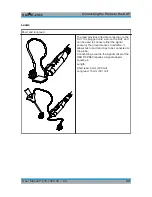
Measurement Principles
R&S
®
RT-ZS60
35
User Manual 1418.7342.02 ─ 04
4.2.1.3
RF Resistance
R
RF1
and R
RF2
(summarized R
RF
) determine the input impedance in the frequency
range from 20
MHz to 2
GHz. Due to the constantly high input impedance of
300
Ω
over the whole range, the loading of high-frequency signals in 50
Ω
envi-
ronments is very small.
4.2.1.4
Input Capacitance C
in
and Minimum Input Impedance |Z
min
|
The input capacitance C
in
causes the input impedance to decrease for high fre-
quencies above 2
GHz. C
in
is very low - Typically under 300
fF.
The minimum input impedance |Z
min
| mainly depends on the connection induc-
tance and the connection type. An overview is given in
Table 4-2
.
4.3
Probing Philosophy
The previous sections explained that probes exert a load on the signal to be mea-
sured and change its characteristic. The signal at the test point where the probe
makes contact (V
in
) is therefore different from the signal that was present before
the probe was connected (V
S
). This effect cannot be avoided and occurs with all
real probes – independent of type and manufacturer.
As a result, there are different opinions which signal is the better output of the
probe:
●
The initial signal that is not loaded by the probe (V
S
), and that corresponds to
the signal at the test point without the probe being connected.
●
The input signal that is loaded with the input impedance of the probe (V
in
) and
that is present between the probe tips.
Both approaches are physically correct and have their individual advantages and
disadvantages. In theory, it is even possible to convert mathematically the two
measurement results into each other, but conversion is a complex transformation
to and from the frequency domain. Probe manufacturers use one or the other of
these two approaches.
Rohde & Schwarz has decided in favor of the user-friendly approach. In our opin-
ion, most users want to know the signal present in the DUT before it was altered
Probing Philosophy






















